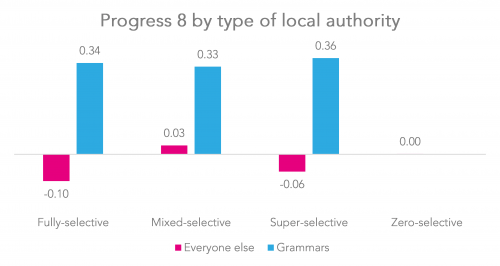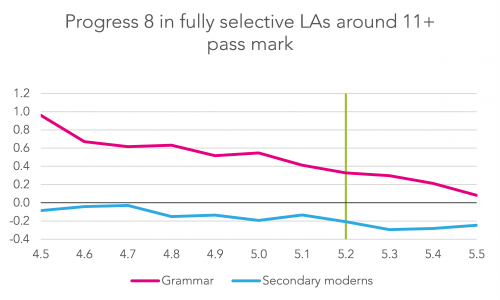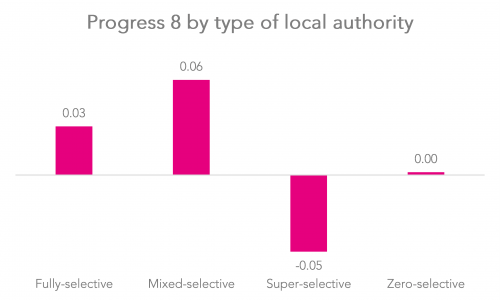Today’s provisional Key Stage 4 data shows a strong Progress 8 performance from grammar schools, and a negative Progress 8 score for those calling themselves secondary moderns. But the positive results of the grammars seem to more than outweigh the negative results of secondary moderns. So, should we use this data to claim that selection has benefits, with few costs? Not so fast…
First, most non-grammar schools in selective local authorities (LAs) do not choose to call themselves secondary moderns. The performance of all non-grammar schools in the fully-selective (i.e. over 20 per cent grammar) areas is actually much worse than that secondary moderns, at an average Progress 8 score of -0.10.
Grammar school Progress 8 figures of around +0.34 translate to pupils being around a third of a GCSE grade higher on average than pupils with the same prior attainment at other schools.
But do these represent true gains made by pupils at grammar schools?
As we explain in an earlier post, there are students who pass the 11-plus and yet have KS2 scores that are well below average. The KS2 score is almost certainly not a good reflection of their academic attainment at the time, yet the grammar school shows fantastic ‘progress’ when they go onto achieve good GCSEs.
For this reason, we concluded that we should look at the overall Progress 8 score in selective LAs. And today’s data shows that it is marginally positive at 0.03 in the fully selective areas.
However, even this figure might not be meaningful.
Academic selection produces large transfers of pupils across LA boundaries, so fully-selective LA results include those who are living in non-selective areas. This is likely (though not certain) to overstate the Progress 8 scores of these selective areas.
Furthermore, these calculations are only made for those in the state sector, yet the presence of grammar schools changes the type of pupils in private schools.
About 12 per cent of those in grammars were in the private sector at age 10 and may well have stayed there had state-selection not been available.
Moreover, large numbers who fail the 11-plus exit the state sector for non-elite private schools.
It is very hard to assess how these private sector transfers affect local authority Progress 8 figure, so we must be cautious before using crude performance table measures to make claims about policy effectiveness.
Want to stay up-to-date with the latest research from Education Datalab? Follow Education Datalab on Twitter to get all of Datalab’s research as it comes out.










There is a further element of complication to this. Since Michael Gove, the government’s preferred curriculum model has been that of a traditional grammar school. It is highly likely that all of the pupils in a grammar school will be taking qualifications that fulfill the requirements of “Progress 8” (i.e. EBacc plus 3 others). In secondary modern schools we cater, by definition, for the less “academic” group of pupils alongside a group of pupils well able to achieve in the EBacc. This means that we, rightly, have a number of students doing courses entirely suited to them, but not all counting towards Progress 8. Pupils may be achieving very good results in these subjects and going on to their preferred post 16 options as a result. But they are not recognised in the single figure measure. Progress 8 is meant to level the playing field, but in fact it continues to tilt the playing filed in favour of schools with academic takes.
One more point to make might concern the attainment on entry of pupils in grammar schools. Most of 2016 year 11 completers did not access the level 6 tests at end of KS2, as these were not universal at that point. However, one assumes that a much larger proportion of pupils who ended up at grammar schools would have reached level 6 than at non selective schools in selective areas. That means that once yeargroups come through who accessed L6 more widely, the progress grammar schools show will fall in comparison with non selectives in selective areas.